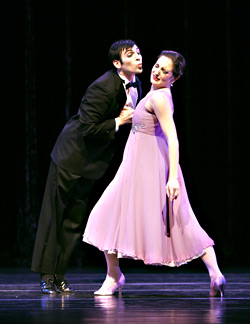Expectations were high as we splashed our way to McCaw Hall Thursday. If anything could lighten the winter gloom, an all-new program of dances with names like Kiss, Red Angels, and Nine Sinatra Songs should do it (Pacific Northwest Ballet’s “Valentine” program runs through Feb. 12; 206-441-2424, www.pnb.org). Then the curtain went up, and for a few minutes, things looked bad indeed. The opening ensemble number of Richard Tanner’s Ancient Airs and Dances was a mess, with the dancers looking jaundiced in yellowish light against a coppery backdrop.
Then the air cleared (as did the lighting). Tanner’s 1992 suite of abstract dances to Ottorino Respighi arrangements of Italian lute music became a showcase for the company, with principal ladies Patricia Barker, Carrie Imler, and Louise Nadeau performing with even more classical flair than usual, particularly in the arm department. The boys did well, too, notably corps member Karel Cruz, but Jonathan Porretta and Olivier Wevers, after muting their beams so agreeably in the first half of the season, are starting to grin too much again. Gentlemen, if we’re looking at your teeth, we can’t concentrate on your footwork.
Susan Marshall’s Kiss, much promoted for its novelty (the dancers wear flying harnesses throughout), didn’t benefit from the advance buzz. It’s a minimal piece, very much of its time (1987), when it seemed that every choreographer on earth was making a dance to Arvo Pärt’s meditative texture music. Marshall’s is admirably unpretentious: a matter of tentative but passionate couplings and releases, performed with clarity by Mara Vinson and James Moore, who were suspended in space yet barely escaped the floor. I look forward to seeing a more ambitious example of her work.
Red Angels is basically all duets all the time. The late Ulysses Dove’s abstract movement is as edgy and scratchy as Richard Einhorn’s electric-violin score (brilliantly executed live by Mary Rowell). It sits particularly well on Ariana Lallone, who is blossoming this season as artistic director Peter Boal explores her potential in roles she would never have been considered for in the past. Corps members Lesley Rausch and Jordan Pacitti turn in performances that pair crisp technical brilliance with utterly deadpan humor. Mr. Wevers, you’re a fine dancer. Please stop smiling.
The arrival of Nine Sinatra Songs in the PNB rep held special personal significance. Both my date and I saw Twyla Tharp’s company perform it here, hot on the heels of its 1982 Vancouver, B.C., premiere. Since then, Tharp has made a virtual second career exploring the show-dancing-with-a- difference idiom she first triumphantly essayed in this piece, while the Songs themselves have become part of the standard repertory in ballet companies across the country.
This is understandable. The piece is audience-friendly, the roles grateful, offering opportunities for 14 dancers in seven couples to shine in a kind of movement that ballet dancers are rarely allowed to attempt—easy, casual, classy, but loose. But it’s not easy to put across. It was made by one of the past mistresses of abstract modernism, and it requires its performers to stroll a stylistic knife-edge, between irony and sentiment, unself-consciousness and self-referentiality.
Even coached by one of the dancers upon whom Tharp created her later style, Shelley Washington, some of the PNB dancers are still a way off finding the essence of their parts. Rausch is lush and lovely in the opening “Softly as I Leave You”; Stanko Milov has to learn that even in romance this insouciant, a gentleman never takes the lady he’s dancing with for granted. Jeffrey Stanton looks dubious rather than delighted by Carla Körbes’ total submission to him in “All the Way.” Christophe Maraval is dandy as the lounge lizard who’s found himself a fine lady in “Strangers in the Night,” but Lallone, a character dancer par excellence, seems oddly unaware of the touch of Groucho-meets–Mrs. Rittenhouse in this nocturnal encounter.
Other couples are already more in tune with the tone. Frequent partners Imler and Porretta tear off “Somethin’ Stupid” with utter brio. When Chalnessa Eames and Anton Pankevitch learn to cope with her dangerously ample Oscar de la Renta gown, their inebriated gyrations in “One More for the Road” will be as touching and beautiful as it is funny—and it is very funny.
I will never to my dying day forget what Tom Rawe and Shelley Freydont made of “That’s Life” back in 1982, but there’s a good chance that Wevers and Kaori Nakamura will find their own way of nailing this virtuosic 20th-century apache dance. Nakamura is already out there without a net. Like Stanton in “All the Way,” Wevers just has to figure out how to handle his lady as if he was in charge. It’s going to be great fun watching him do it.








